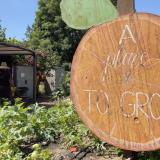Science Blender | Interdisciplinary Breakthrough Creates A World in Higher Decibels Student Essay from the HON 389 Science Blender Course
November 19, 2015
Throughout the year, we will be publishing essays from Professor Andrew Lyon‘s Honors 389 course “The Science Blender” . For the second paper this term, students were asked to investigate an “interdisciplinary breakthrough”. Below is one student’s essay on the topic.
At around the age of 10, I knew something was wrong. With eyes bulging like a newborn pug, I remember blankly staring at my friend Auroara, as I tried to interpret words through fragmented syllables. She had been yelling my name across the across the table for a whole 10 minutes. It was then that I knew: I was hard of hearing.
Despite how discovering my condition at the time felt, I am not alone in this prognosis. Nearly 36 million people suffer from disabling hearing loss. Technologies that have intensively progressed within just the last decade, however, changed “suffering” into “benefiting.” The solutions to my hearing predicament, at the time, were simpler and limited. There was no discrete subtlety about those hearing aids. They were just large, technological devices that amplified feedback and often projected sounds to distorted frequencies.
Audiology has come a long way since then. Over the years, hearing aid sizes have been reduced to fit snugly within the ear canal, providing wearers the option to conceal their disability, just as the visually impaired prefer contacts over glasses.
In order to combat the lack of frequency precision, Oticon took advantage of the rising popularity of computerized technology. With the backing of computational engineering, sound amplification took a path towards clarity. Following Oticon’s lead, hearing aid companies around the nation began to develop software to operate and perfect the performance of their devices.
Within just the past year, hearing aids became seamlessly compatible with Bluetooth, creating an easily accessible world of sound to the soundless. Users are now able to connect their hearing aids to any technological device, which in my life, means having the perfect ear buds to drown reality in music. Instead of tolerating the static struggle of listening through a phone receiver, hearing aid owners are able to directly sync their devices to their calls with just a few clicks on a Bluetooth adapter.
Instead of using a separated remote, some hearing companies expanded their possibilities by taking advantage of an application interface. With just a simple download from iTunes or PlayStore, the hard of hearing are able to access and adjust the volume of their world from their smart phones.
The new integrated software provides hearing aid wearers the possibility of amplifying certain sounds and muting others. Frequency detection within newer hearing aids possess the ability to separate environmental noise from conversation. Using an online app or website, users can choose the sounds they enjoy hearing and reject the ones that they don’t, such as muting dog barks or train whistles.
Most innovatively of all, hearing aids actually record and observe the situational volume changes a user makes. Through data mining, the newer software detects patterns within the wearer’s audible comfort range and automatically learns to adjust the volume in order adapt to changes in noisy climates. Hearing has become a technology that can be electronically computed and stored.
By possessing the ability to amplify and cast away various sounds and frequencies, the hard of hearing are able to experience life in a new medium, altering their reality in a few clicks. With the interdisciplinary breakthrough between computational sciences and audiology, hearing disabilities have become superabilities.
About Honors 389: The Science Blender
Throughout Professor Lyon’s Science Blender course, students identify knowledge gaps that prevent simple solutions to grand challenges, and then they develop strategies to address those gaps. In this process, students also become more conversant in the languages of different disciplines and how team-based problem solving benefits scientific pursuits


